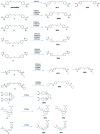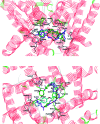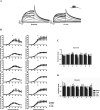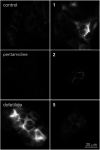Drug-likeness of linear pentamidine analogues and their impact on the hERG K+ channel - correlation with structural features
- PMID: 35540224
- PMCID: PMC9082326
- DOI: 10.1039/c9ra08404e
Drug-likeness of linear pentamidine analogues and their impact on the hERG K+ channel - correlation with structural features
Abstract
This work presents drug-likeness and the cardiotoxicity profiles of six potent pentamidine analogs 1-6 and three new compounds 7-9 as chemotherapeutics for therapy of Pneumocystis jiroveci pneumonia. A combination of experimental and computational approaches was used in the cardiotoxicity examination. The hERG trafficking and functionality of the hERG currents were tested by western blot analyses, immunofluorescent staining procedures, and patch-clamp electrophysiological assays. Cardiotoxicity combined with blocking the hERG K+ channel was predicted, and then simulated by docking to the CSM-TM model 732 protein. Location of pentamidines in the proximity of Leu622, Thr623, Ser649, Tyr652, Ala653, and Phe656, and the high energies of interactions were in accordance with probable blocking of the hERG channel. However, in the biochemical experiments, no significant changes in I hERG densities and a minor effect on hERG maturation were observed. Predicted metabolic transformation of pentamidines with S atoms in the aliphatic linker leads to oxidation of one S atom, but those with the phenyl sulfanilide moiety can be oxidized to chinones. The tested pentamidines characterized by the presence of sulfur atoms or sulfanilide groups, have favorable drug-likeness parameters and are promising lead structures in the development of new potent chemotherapeutics against PJP.
This journal is © The Royal Society of Chemistry.
Conflict of interest statement
There are no conflicts to declare.
Figures









Similar articles
-
A human ether-á-go-go-related (hERG) ion channel atomistic model generated by long supercomputer molecular dynamics simulations and its use in predicting drug cardiotoxicity.Toxicol Lett. 2014 Nov 4;230(3):382-92. doi: 10.1016/j.toxlet.2014.08.007. Epub 2014 Aug 13. Toxicol Lett. 2014. PMID: 25127758
-
Deposition of pentamidine analogues in the human body - spectroscopic and computational approaches.Eur J Pharm Sci. 2021 Jun 1;161:105779. doi: 10.1016/j.ejps.2021.105779. Epub 2021 Mar 2. Eur J Pharm Sci. 2021. PMID: 33667666
-
Mechanism of hERG K+ channel blockade by the fluoroquinolone antibiotic moxifloxacin.Br J Pharmacol. 2006 Apr;147(8):905-16. doi: 10.1038/sj.bjp.0706678. Br J Pharmacol. 2006. PMID: 16474415 Free PMC article.
-
Physicochemical basis for binding and voltage-dependent block of hERG channels by structurally diverse drugs.Novartis Found Symp. 2005;266:159-66; discussion 166-70. Novartis Found Symp. 2005. PMID: 16050267 Review.
-
Structural determinants for high-affinity block of hERG potassium channels.Novartis Found Symp. 2005;266:136-50; discussion 150-8. Novartis Found Symp. 2005. PMID: 16050266 Review.
References
LinkOut - more resources
Full Text Sources
Other Literature Sources

